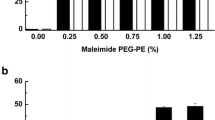Abstract
Bovine liver superoxide dismutase (SOD) can be crosslinked to albumin to form soluble conjugates with up to 70% retention of original enzyme activity. These conjugates have markedly prolonged plasma half-times of enzymatic activity (15 h) compared to native SOD (6 min). The conjugates have potent anti-inflammatory effects in vivo and reduced immunogenicity and antigenicity compared to native SOD. These conjugates provide new possibilities for the study of inflammation and its treatment.
Similar content being viewed by others
References
I. Fridovich,The Biology of Oxygen Radicals, Science201, 875–880 (1978).
B.M. Babior,Oxygen-Dependent Microbial Killing by Phagocytes, N. Engl. J. Med.298, 659–668, 721–725 (1978).
R.K. Root andJ.A. Metcalf,H 2 O 2 Release from Human Granulocytes During Phagocytosis: Relationship to Superoxide Anion Formation and Cellular Catabolism of H 2 O 2 : Studies with Normal and Cytochalasin B Treated Cells, J. Clin. Invest.60, 1266–1279 (1977).Oxidation and Oxygen Reduction by the Granule-Rich Fraction Isolated from Human Polymorphonuclear Blood Cells, FEBS Lett.97, 50–54 (1979).
E.W. Kellogg andI. Fridovich,Superoxide, Hydrogen Peroxide, and Singlet Oxygen in Lipid Peroxidation by a Xanthine Oxidase System, J. Biol. Chem.250, 8812–8817 (1975).
J.M. McCord andD. Day Jr.,Superoxide-Dependent Production of Hydroxyl Radical Catalyzed by Iron-EDTA Complex, FEBS Lett.86, 139–142 (1978).
R.B. Johnston Jr., B.B. Keele Jr., H.P. Misra, J.E. Lehmeyer, L.S. Webb, R.L. Baehner andK.V. Rajagopalan,The Role of Superoxide Anion Generation in Phagocytic Bactericidal Activity, J. Clin. Invest.55, 1357–1372 (1975).
I.M. Goldstein, C.L. Malmsten, H.B. Kaplan, H. **dahl, B. Samuelsson andG. Weissman,Thromboxane Generation by Stimulated Human Granulocytes: Inhibition by Glucocorticoids and Superoxide Dismutase, Clin. Res.25, 518A (1977).
J.M. McCord,Free Radicals and Inflammation: Protection of Synovial Fluid by Superoxide Dismutase, Science185, 529–531 (1974).
J.M. McCord, K. Wong, S.H. Stokes, W.F. Petrone, andD. English,A Mechanism for the Anti-Inflammatory Activity of Superoxide Dismutase, in:Active Oxygen and Medicine (Ed. A.P. Autor; Raven Press, New York 1979), in press.
W. Huber andM.G.P. Saifer,Orgotein, the Drug Version of Bovine Cu−Zn Superoxide Dismutase: I. A Summary Account of Safety and Pharmacology in Laboratory Animals, in:Superoxide and Superoxide Dismutases (Eds. A.M. Michelson, J.M. McCord and I. Fridovich; Academic Press, London 1977), pp. 517–536.
K.G. Menander-Huber andW. Huber,Orgotein, the Drug Version of Bovine Cu−Zn Superoxide Dismutase: II. A Summary Account of Clinical Trials in Man and Animals, in:Superoxide and Superoxide Dismutases (Eds. A.M. Michelson, J.M. McCord and I. Fridovich; Academic Press, London 1977), pp. 537–549.
J.M. McCord andK. Wong,Phagocyte-Produced Free Radicals: Roles in Cytotoxicity and Inflammation, in:Oxygen Free Radicals and Tissue Damage (CIBA Foundation Series 65; Elsevier/Excerpta Medica/North Holland, Amsterdam 1979), pp. 343–360.
M. Poznansky,Perspectives of Soluble Cross-Linked Enzyme Polymers for Enzyme Therapy, in:Biomedical Applications of Immobilized Enzymes and Proteins, vol. 2 (Ed. T.M.S. Chang; Plenum Press, New York 1977), pp. 341–345.
M.H. Remy andM.J. Poznansky,Immunogenicity and Antigenicity of Soluble Cross-Linked Enzyme/Albumin Polymers: Advantages for Enzyme Therapy, Lancet2, 68–70 (1978).
M.M. Bradford,A Rapid and Sensitive Method for the Quantitation of Microgram Quantities of Protein Utilizing the Principle of Protein-Dye Binding, Anal. Biochem.72, 248–254 (1976).
P.O. Seglen,Preparation of Rat Liver Cells III, Enzymatic Requirements for Tissue Dispersion, Exp. Cell Res.82, 391–398 (1973).
K.F. Swingle,Evaluation of Anti-Inflammatory Activity, in:Anti-Inflammatory Agents, vol. 2,Chemistry and Pharmacology (Eds. R.A. Scherrer and M.W. Whitehourse; Academic Press Inc., New York 1974), pp. 33–122.
O. Ouchterlony andL.A. Nilsson,Immunodiffusion and Immunoelectrophoresis, in:Handbook of Experimental Immunology, 2nd edn. (Ed. D.M. Weir; Blackwell Scientific Publications, Oxford 1973), pp. 19.1–19.3.
A. Abuchowski, J.R. McCoy, N.C. Palczuk, T. Van Es andF.F. Davis,Effect of Covalent Attachment of Polyethylene Glycol on Immunogenicity and Circulating Life of Bovine Liver Catalase, J. Biol. Chem.252, 3582–3586 (1977).
Author information
Authors and Affiliations
Rights and permissions
About this article
Cite this article
Wong, K., Cleland, L.G. & Poznansky, M.J. Enhanced anti-inflammatory effect and reduced immunogenicity of bovine liver superoxide dismutase by conjugation with homologous albumin. Agents and Actions 10, 231–239 (1980). https://doi.org/10.1007/BF02025941
Received:
Issue Date:
DOI: https://doi.org/10.1007/BF02025941




